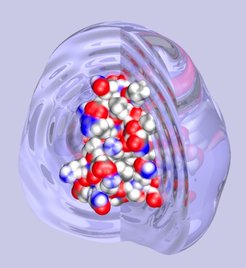Correlated Collective Dynamics in Proteins and their Solvating Environment

We analyze the mutual influence between dynamical processes in solvated biomolecules and their surrounding solvent in molecular dynamics simulations. Particularly for water-soluble proteins, vibrational motions in the far-infrared frequency range between 30 and 300 cm-1, i.e. 1 to 10 terahertz, play a special role. In this spectral range we find the intermolecular vibrations of the water hydrogen bond network, as well a multitude of vibrations of the proteins solvated therein. Using cross correlation functions resolved in time and space, we were able to show that the vibrations of the protein and water in the surrounding hydration shell are influencing each other in this frequency range over distance of up to 10 Å. With this, we were able to provide, for the first time, a theoretical explanation for the experimental observation of a modified absorption of the water vibrations in this part of the spectrum.
The goal of this project is to study in detail the consequences of these correlated vibrational motions for the dynamics of solvated proteins, for example by perturbing the underlying the mechanical coupling between the protein and its surrounding solvent, in simulations as well as in accompanying experiments of our collaborators.
Of particular interest is the question, if the observed long ranged correlations resemble an adaption of protein, in particular enzymes, to their natural environment, which is relevant for their function. Existing experimental approaches, which modify the catalytical properties of enzymes through the applied solvent, make the existence of such a mechanism seem very plausible.
A detailed understanding of such an active role of the solvent will be of great importance for knowledge-based modifications of biochemical processes, for example the development of highly specific drugs or the use of enzymes in the synthesis of complex chemical compounds.
